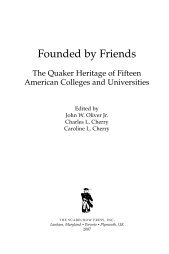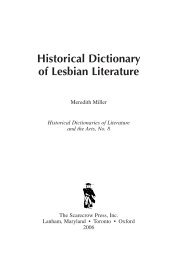Postwar German Cinema and the Horror Film - Scarecrow Press
Postwar German Cinema and the Horror Film - Scarecrow Press
Postwar German Cinema and the Horror Film - Scarecrow Press
Create successful ePaper yourself
Turn your PDF publications into a flip-book with our unique Google optimized e-Paper software.
xviii Steffen Hantke<br />
<strong>and</strong> began to make a name for himself, first with studio fare like Son of Dracula<br />
(1943), <strong>and</strong> <strong>the</strong>n with noir masterpieces on <strong>the</strong> boundaries between horror,<br />
thriller, <strong>and</strong> mystery, like Phantom Lady (1944), The Spiral Staircase (1946),<br />
The Killers (1946), <strong>and</strong> The Dark Mirror (1946). 19 The trajectory of Siodmak’s<br />
career—from prewar <strong>German</strong>y to Hollywood, <strong>and</strong> back again to <strong>German</strong>y after<br />
<strong>the</strong> war—is something he shares with Lang <strong>and</strong> Lorre. As returning exiles, all<br />
three provide case studies in historical discontinuity, raising questions about <strong>the</strong><br />
transfer of expressionist style from one context to ano<strong>the</strong>r. Each essay devotes<br />
itself to a film made after Lang, Lorre, <strong>and</strong> Siodmak had returned from <strong>the</strong> U.S.<br />
to postwar <strong>German</strong>y. Blair Davis deals with Lang’s film Die Tausend Augen des<br />
Dr. Mabuse (1960), in which Lang resurrected his prewar villain for <strong>the</strong> postwar<br />
audience, while Tony Williams takes on Lorre’s sole directorial work in Der<br />
Verlorene (1951), in which Lorre created an opportunity for himself to insert his<br />
own American-made persona into a traumatic postwar <strong>German</strong>y unwilling to<br />
confront its immediate past. My own piece, finally, focuses on Siodmak’s film<br />
Nachts, wenn der Teufel kam (1957), in which Siodmak deploys a variety of<br />
styles he had continued to refine during his career as a versatile studio director<br />
in an attempt to outwit a recalcitrant postwar <strong>German</strong> audience.<br />
The second section of <strong>the</strong> anthology, entitled “<strong>German</strong> Autorenkino <strong>and</strong><br />
<strong>Horror</strong> <strong>Film</strong>: Influences, Dialogues, Exchanges,” focuses on <strong>the</strong> fruitful, though<br />
conflicted relationship that exists between <strong>the</strong> <strong>German</strong> Autorenfilm, which frequently<br />
bears <strong>the</strong> burden of having to represent all of <strong>German</strong> cinema abroad,<br />
<strong>and</strong> <strong>the</strong> tropes <strong>and</strong> motifs of <strong>the</strong> horror film as a representative of genre cinema.<br />
As Vergangenheitsbewältigung serves as a leitmotif for <strong>the</strong> previous section, <strong>the</strong><br />
boundary between auteurist filmmaking <strong>and</strong> horror film as a form of popular<br />
entertainment provides <strong>the</strong> <strong>the</strong>me that holds this section toge<strong>the</strong>r. It is <strong>the</strong> purpose<br />
of this section to challenge <strong>the</strong> assumption that <strong>the</strong> two areas are mutually<br />
exclusive, <strong>and</strong> to suggest that a disdain toward <strong>the</strong> horror film on <strong>the</strong> part of influential<br />
<strong>German</strong> filmmakers would produce a critical misrepresentation of<br />
postwar <strong>German</strong> cinema. The section opens with Linda Badley’s examination of<br />
<strong>the</strong> tumultuous relationship between one of <strong>the</strong> premiere filmmakers of <strong>the</strong> New<br />
<strong>German</strong> cinema, Werner Herzog, <strong>and</strong> his notorious star Klaus Kinski, entitled<br />
“The Shadow <strong>and</strong> <strong>the</strong> Auteur: Herzog’s Kinski, Kinski’s Nosferatu, <strong>and</strong> <strong>the</strong><br />
Myths of Authorship.” Badley’s exclusive interest is not Herzog’s remaking of<br />
Murnau’s classic Nosferatu; this subject has been sufficiently discussed by o<strong>the</strong>r<br />
critics interested in horror film. Instead, Badley focuses on <strong>the</strong> trope of monstrosity<br />
that haunts notions of auteurist filmmaking <strong>and</strong> “inspired” acting, serving<br />
as an organizing metaphor for numerous recent meta-horror films. Richard<br />
H<strong>and</strong>’s essay “History, Homage <strong>and</strong> <strong>Horror</strong>: Fassbinder, Raab, Lommel <strong>and</strong> The<br />
Tenderness of Wolves (1973)” takes on, albeit obliquely, ano<strong>the</strong>r figure central<br />
to <strong>the</strong> pan<strong>the</strong>on of <strong>German</strong> Autorenfilm, Rainer Werner Fassbinder, by way of<br />
Fassbinder’s association with Uli Lommel <strong>and</strong> Kurt Raab, a director <strong>and</strong> an actor<br />
whose careers he helped to set in motion. Lommel’s film about, <strong>and</strong> Raab’s<br />
portrayal of, serial murderer Fritz Haarmann are, similar to Herzog taking re-
















